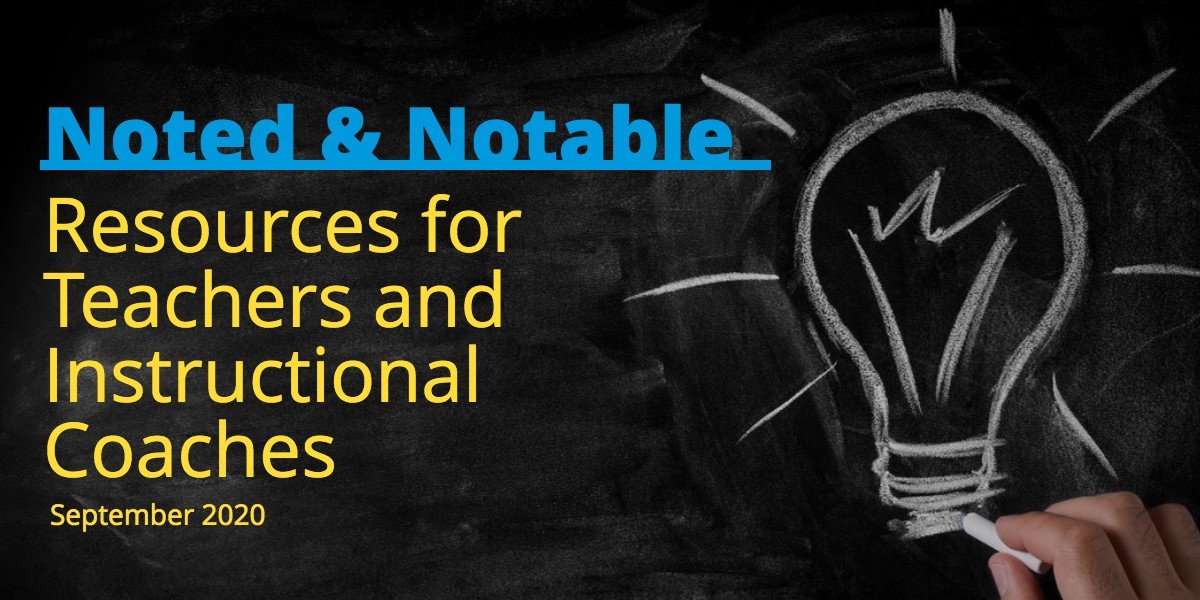Top Reading for Instructional Coaches and Teachers – September 2020

We are now moving into our second month of this school year. Although many educators are starting to get the hang of how to operate in this different landscape, there are still lessons to be learned. Some teaches are cultivating new distance learning student engagement strategies, while others have found new creative ways to focus on their student’s emotional well-being. Overall, many districts have created roadmaps for how to successfully combat some of the biggest challenges educators are facing during this time. Here are some resources for educators, support staff, and even parents centered around ideas such as the homework gap between students with high-speed internet and those without it, the pandemic pod as a solution to a lack of social interaction amongst distance learning students, and the concept of a structured recess to ensure students can still have interaction at schools in a socially distanced world.
Solutions for the urgent need to close the homework gap for students
The homework gap is the phrase used to describe the inequities that exist when some students have access to high-speed internet access at home and those that do not. According to a study from Common Sense Media, 30% of all public K-12 students fall into this phenomenon.
The homework gap disproportionately affects students from families of color and in low-income households. Common Sense found that 26% of Latinx students and 30% of Black students lacked high-speed internet access. An earlier study from the Pew Research Center (Anderson & Perrin, 2018) showed that among families earning less than $30,000 per year, one-third lacked high-speed internet access. The homework gap also has a geographical component: Common Sense’s study found 37% of rural students lacked adequate connectivity in their homes, a percentage far higher than among suburban (25%) and urban (21%) students.
It’s no secret that computers and high-speed internet have played an increasingly large role in student success over the past few decades. These resources are necessary for students to complete assignments, communicate with their teachers, manage their scheduling, and stay informed about academic requirements. Without current devices and high-speed internet access, some students are completely left behind.
The Covid-19 pandemic has escalated the need for access and exacerbated the inequities. As districts increasingly move to hybrid and virtual models for reopening this fall, the students who fall into the homework gap are left without a meaningful chance for success. If a school district opts for a fully virtual model or hybrid model, families without high-speed internet access will be unable to access instruction, even if schools provide laptops or tablets.
Read more on Learning Forward: Closing The Homework Gap Is More Important Than Ever
Pandemic pods’ are a unique solution to ensure distance learning students can still have social interaction
Many parents are forming “pandemic-pods” to ensure that their children continue to have social and academic interaction. In these learning pods, families create closed small groups to provide and share childcare, curriculum, or both.
In some cases, parents are using tools like Facebook—the main “Pandemic Pods” Facebook group had nearly 40,000 members in mid-August—to essentially start their own one-room schoolhouses. Families are recruiting teachers to lead their pods and paying as much as $125,000 under these arrangements—more than most teachers make in an ordinary year. Some teachers are figuring out ways to work with multiple pods to increase their earnings.
In other cases, parents are depending on existing online programs to provide instruction for their pod. For curriculum, some families are remaining enrolled in their district school but following that program in their pod. Others are enrolling their children in virtual schools, such as the public charter and private-school programs run by K12, Inc., Connections Academy, or Laurel Springs School. Although the efficacy of virtual schools, particularly those in the charter sector, has come under attack, families’ willingness to try these types of programs appears to be changing. Relative to the remote learning options a traditional district school is cobbling together, the offerings of virtual charters often look quite robust in comparison, as they provide both curriculum and teachers.
Read more on EducationNext: The Rapid Rise of Pandemic Pods
Guided Play and structured recess might be the key to safe student outdoor time
What happens when recess collides with strict social distancing protocols? Although simply removing recess may be the easiest option, many schools are finding out that this is not in the long-term best interests of their students.
“We know that one of the key purposes of play is socialization,” says Katie Salen, a professor at the University of California, Irvine, who studies game design and learning. By around 3-years-old, kids begin to play productively with one another and engage in peer-based play, which helps kids learn how to make friends and interact with other people. “Once they enter pre-adolescence, it’s very peer-based,” she explains. “The play and experimentation is very much rooted in the peer group and issues of exploring identity and friendship and belonging.”
There are other reasons to value play, especially these days: It’s often used as a way to help kids cope with their emotions during potentially traumatic situations. In countries such as Bangladesh and Uganda, play labs are spaces devoted to play and socialization, used in refugee camps to help children process their experiences. Separately, one international study looked at children caught in conflict and natural disasters and showed that kids use play as both a coping mechanism and, over time, as a way to build resilience.
Read more on Edsurge: What Should Recess — and Play — Look Like in a Socially Distanced World?
